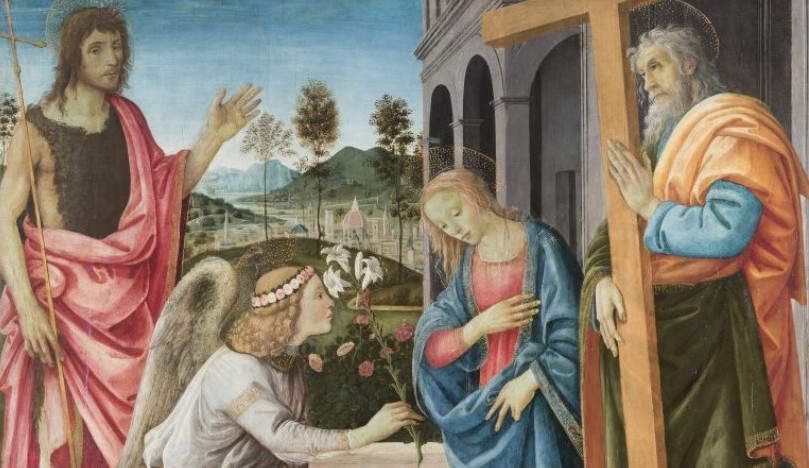After restoration, Filippino Lippi ’sAnnunciation with Saints John the Baptist and Andrew is back on display at the Museo e Real Bosco di Capodimonte. The restoration of the work, a tempera on panel dated around 1470-75, was made possible thanks to the support of the company Temi Spa, which usedArt Bonus tax breaks.
The same company had already supported the museum in the restoration of the Portrait of the Infante Francesco I di Borbone by Elisabeth Vigée Le Brun, as part of the Rivelazioni Finance for Fine Arts project carried out by Borsa Italiana in collaboration with the Advisory Board of the Museo e Real Bosco di Capodimonte, a project in which the restoration of the Filippino Lippi is also included, completing a’operation that involved as many as eight important paintings at the museum site, such as theAdoration of the Shepherds by Giovan Battista Salvi known as Sassoferrato, the Nativity by Luca Signorelli, Bernardo Cavallino’s The Singer and Adoration of the Child by Michelangelo Anselmi, Claude Lorrain’s Landscape with the Nymph Egeria, Elisabeth Vigée Le Brun’s Portrait of the Infant Francis of Bourbon, and Titian’s Portrait of Pier Luigi Farnese.
Restorations made possible thanks to companies from Campania that are members of the ELITE project, the international program of Borsa Italiana established in 2012 in collaboration with Confindustria dedicated to companies with high growth potential: Sabato D’Amico’s D&D Italia Spa, Fabio De Felice’s Protom, Fulvio De Iuliis’ Cartesar, Carmine Esposito’s Epm, Salvatore Amitrano’s Pasell, Vito Grassi’s Graded, Giovanni Lombardi’s Tecno srl, and Gennaro Matacena’s Caronte Spa.
Filippino Lippi’sAnnunciation was restored by Bruno Arciprete and Roberto Buda (support), with investigations conducted by Beatrice De Ruggieri, Matteo Positano, Marco Cardinali (Emmebi Diagnostica Artistica); Claudio Falcucci, under the supervision of Angela Cerasuolo, head of the Restoration Department of the Capodimonte Museum and Real Bosco.
The restoration involved both the support and the painted surface. Recently the painting had progressively shown signs of instability, due to thermo-hygrometric variations and the constrictive constraint of the support structure. New cracks had been created in the support, with lesions and lifting of the pictorial layers, necessitating the current intervention.
The restoration of the support entailed removing the metal crossbeams with the gradual removal of the wooden dowels that anchored them, restoring the cracks with the insertion of triangular-section dowels glued after aligning the edges of the pictorial surface, and integrating with poplar wood dowels the perimeter support parts that had been thinned in the past to apply the frame. Once freed from the constricting constraint of the crossbeams, the support gradually assumed a convex profile on the pictorial front. The new support structure was prepared with two chestnut wood crosspieces with a curvature whose profile conformed to that assumed by the work, applied by means of cylindrical wooden dowels bearing a Teflon screw and brass registers with conical springs calibrated to follow the dimensional variations of the planking. The wooden surface was impregnated with permethrin in solvent to protect it from xylophagous insect infestation. Laths coated with scratch-resistant material were applied to the sash of the frame to accompany the curved profile of the board, which was fixed with elastic restraints.
The pictorial surface was covered with a thick layer of obscured varnish that distorted and reduced the reading of the original color scheme. There were also numerous interventions of pictorial integration along the commettiture of the axes where, through UV fluorescence investigation, extensive fillings corresponding to severe, deep losses of pictorial material were revealed. These were particularly noticeable at the four plank commectations that had been subject to wood movement several times in the past and had become disjointed. There were also other old additions now altered in tone, executed on abraded or torn areas. Some burns on the pictorial surface were noted on the sides, particularly under the right hand of St. John and on the green mantle of St. Andrew, damage produced by the flame of candles placed next to the painting, characterized by the typical spear shape. The cleaning of the pictorial surface involved the gradual removal of altered paint layers and repainting. After cleaning, vivid color fields emerged that, although compromised, restored a luminous composition. The plasterwork was overhauled and, where necessary, corrections were made or new plaster was put in place, with Bologna plaster and animal glue. With the pictorial integration, carried out with powdered pigments and varnish, the intention was to harmonize the compromised parts with the original ones, balancing, as far as possible, with minimal intervention the lacunose or worn parts.
Image: Filippino Lippi, Annunciation with Saints John the Baptist and Andrew, detail (c. 1470-75; tempera on panel; Naples, Museo e Real Bosco di Capodimonte)
 |
| Filippino Lippi's Annunciation returns on display restored at Capodimonte Museum |
Warning: the translation into English of the original Italian article was created using automatic tools. We undertake to review all articles, but we do not guarantee the total absence of inaccuracies in the translation due to the program. You can find the original by clicking on the ITA button. If you find any mistake,please contact us.